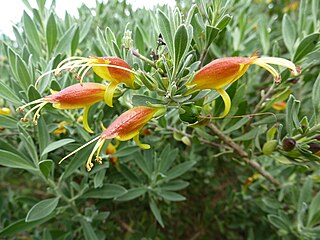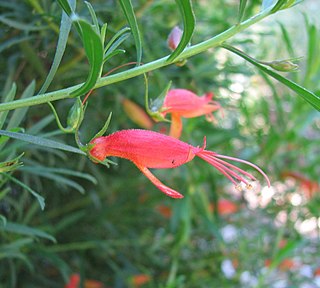
Eremophila youngii is a flowering plant in the figwort family, Scrophulariaceae and is endemic to Western Australia. It is a dense, erect shrub with many of its parts covered with a layer of grey to yellowish-grey scales and with pink, purple or red flowers.

Eremophila glabra, commonly known as tar bush, is a plant in the figwort family, Scrophulariaceae and is endemic to Australia. It is sometimes a low, ground-hugging and sometimes an erect shrub. The leaves are variable in size and shape and there is a range of flower colours. In spite of its scientific name, not all forms of the plant are glabrous but most have many small, raised glands on the stems, flowers and leaves.

Eremophila maculata, also known as spotted emu bush or spotted fuchsia-bush, is a plant in the figwort family Scrophulariaceae, and is endemic to Australia. It is the most widespread of its genus in nature and probably the most frequently cultivated Eremophila. It is a spreading, often densely branched shrub with variable leaf shape and flower colour, but the other features of the flowers such as the size and shape of the parts are consistent. The inside of the flower is often, but not always, spotted.

Eremophila oldfieldii, commonly known as pixie bush, is a flowering plant in the figwort family, Scrophulariaceae and is endemic to Western Australia. It is a shrub or small tree with rough bark, broad, flat or narrow fleshy leaves and red, orange or yellow flowers.

Eremophila latrobei, commonly known as crimson turkey bush, native fuchsia, Latrobe's emu bush, grey fuchsia bush, warty fuchsia bush and Georgina poison bush is a flowering plant in the figwort family, Scrophulariaceae and is endemic to Australia. It is an erect, highly branched shrub with usually linear leaves and red to purple-red flowers and which occurs in all mainland states, including the Northern Territory but excluding Victoria.

Eremophila bowmanii, also known as silver turkeybush, Bowman's poverty bush and flannel bush, is a flowering plant in the figwort family, Scrophulariaceae and is endemic to New South Wales and Queensland in Australia. It is a low to medium, spreading shrub with silvery-grey, hairy foliage and blue to lilac flowers, and sometimes grows in dense thickets with mulga.

Eremophila decipiens, commonly known as slender fuchsia bush or narrow-leaved fuchsia bush is a flowering plant in the figwort family, Scrophulariaceae and is endemic to an area extending from the south-west of Western Australia to southern parts of South Australia. It is low, sprawling shrub with lance-shaped leaves and red, orange or yellow flowers on a long, S-shaped stalk.

Eremophila denticulata, also known as toothed eremophila, toothed poverty bush and Fitzgerald eremophila, is a flowering plant in the figwort family, Scrophulariaceae and is endemic to the south-west of Western Australia. It is an erect shrub with red flowers and leaves that have toothed margins.

Eremophila fraseri, commonly known as burra or jilarnu, is a flowering plant in the figwort family, Scrophulariaceae and is endemic to Western Australia. It is a shrub or small tree with all above-ground parts of the plant, apart from the petals, sticky and shiny due to the presence of a large amount of resin. The petals are coloured white, cream, pink and brown.
Eremophila compacta, commonly known as compact poverty bush, is a flowering plant in the figwort family, Scrophulariaceae and is endemic to the central west of Western Australia. There are two distinct subspecies differing in their growth habit but both have grey leaves due to a covering of white or grey hairs, and purple to blue, rarely white flowers.

Eremophila densifolia is a flowering plant in the figwort family, Scrophulariaceae and is endemic to the south-west of Western Australia. It is usually a low, spreading shrub with densely clustered leaves and lilac to purple flowers.

Eremophila forrestii, commonly known as Wilcox bush is a flowering plant in the figwort family, Scrophulariaceae and is endemic to Australia. It is a many-branched shrub with its branches, leaves and sepals densely-covered with a thick layer of greyish or yellowish hairs giving the plant a felty appearance. Its flowers are cream-coloured to pink and are spotted or streaked dark red. It occurs mostly in Western Australia but also in the far west of South Australia and the Northern Territory. Six subspecies are recognised by the Western Australian Government Department of Parks and Wildlife.

Eremophila goodwinii, commonly known purple fuchsia bush and Goodwin's emu bush is a flowering plant in the figwort family, Scrophulariaceae and is endemic to Australia. It is a small, spreading or erect shrub with most parts sticky due to the presence of resin, tapering leaves and pale lilac to mauve flowers. It occurs in New South Wales, the Northern Territory and Queensland.

Eremophila jucunda is a flowering plant in the figwort family, Scrophulariaceae and is endemic to Western Australia. It is a small to medium-sized shrub with hairy branches and leaves, lance-shaped to egg-shaped leaves and cream-coloured, lilac or purple flowers.

Eremophila obovata is a flowering plant in the figwort family, Scrophulariaceae and is endemic to Australia. It is a low, compact shrub with lilac to purple flowers growing mainly in the Northern Territory and Queensland but also Western Australia, South Australia and New South Wales.
Eremophila petrophila is a flowering plant in the figwort family, Scrophulariaceae and is endemic to Western Australia. It is a tall, erect, open shrub with rough branches, narrow, sticky leaves and pale lilac-coloured flowers.

Eremophila platythamnos, commonly known as desert foxglove, is a flowering plant in the figwort family, Scrophulariaceae and is endemic to Australia. It is an erect shrub with short, broad leaves and purple, mauve, blue or pink flowers.
Eremophila simulans is a flowering plant in the figwort family, Scrophulariaceae and is endemic to Western Australia. It is an erect shrub with broad, serrated leaves and violet to purple flowers.

Eremophila spectabilis, commonly known as showy poverty bush, is a flowering plant in the figwort family, Scrophulariaceae and is endemic to Western Australia. It is a dense, erect shrub with narrow, greyish leaves and blue, mauve or purple flowers.
Eremophila verrucosa is a flowering plant in the figwort family, Scrophulariaceae and is endemic to South Australia. It is an erect, broom-shaped shrub with its leaves and branches covered with yellow-grey scales and lilac to purple flowers.

















